[1]
R. Williams s., i., A. -R. Josh, Planar parallel 3 - prp manipulator, in Procs. of 6th of CAMR, p.4229–4235, (2006).
Google Scholar
[2]
G. Fried, K. Djouani, D. Borojeni, S. Iqbal, Determination of 3-rpr planar parallel robot assembly modes by jacobian matrix factorization, J. WSEAS Transaction on Systems, 72(2): 41–48, (2008).
Google Scholar
[3]
S. Staicu, Z. -W. Li, X. -J. Liu, J. Wang, L. -P. Wang, Matrix model in inverse dynamics of a 3-dof spatial parallel manipulator, J. U.P.B. Sci. Bull., Series D, 68 (1): 3–14, (2006).
Google Scholar
[4]
J. Kim, M. -Y. Cho, F. Park, J. M. Lee, Design of a parallel mechanism platform for simulating six degrees-of-freedom general motion including continuous 360-degree spin, CIRP Annals - Manufacturing Technology, 52(1): 347–350, (2003).
DOI: 10.1016/s0007-8506(07)60598-8
Google Scholar
[5]
J. -P. Merlet, Parallel Robots, Springer, Dordrecht, Holland, second edition, (2006).
Google Scholar
[6]
C. Lapusan, F. Fodor, C. Brisan, A. Csiszar, A. Verl, - Aspects concerning the modeling of robots with increased dexterity, ISR/Robotik 2014 - 41st International Symposium on Robotics; 6th German Conference on Robotics, Munich, (2014).
Google Scholar
[7]
J. -P. Merlet, C. -M. Gosselin, Nouvelle architecture pour un manipulateur parallèle a six dégrées de liberté e. J. Mechanism and Machine Theory, 26(1): 77–90, (1990).
DOI: 10.1016/0094-114x(91)90023-w
Google Scholar
[8]
Information on: http: /www. festo. com/rep/en_corp/assets/pdf/info_501_en. pdf.
Google Scholar
[9]
C. Brisan, C. Boanta, A. Csiszar, A. Verl – Aspects concerning kinetostatic properties of parallel robots, ISR/Robotik 2014; 41st International Symposium on Robotics, Munich, (2014).
Google Scholar
[10]
C. Brisan, A. Csiszar, Computation and analysis of the workspace of a reconfigurable parallel robotic system, Mechanism and Machine Theory, pp.1647-1668, (2011).
DOI: 10.1016/j.mechmachtheory.2011.06.014
Google Scholar
[11]
D. Zhang - Kinetostatic analysis and optimization of parallel and hybrid architectures for machine tools, Ph. D. Thesis, Laval University, Quebec, April (2000).
Google Scholar


